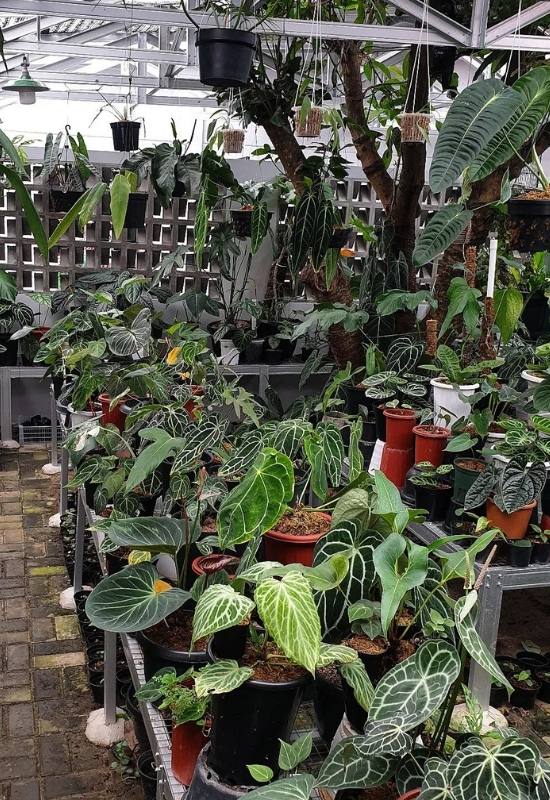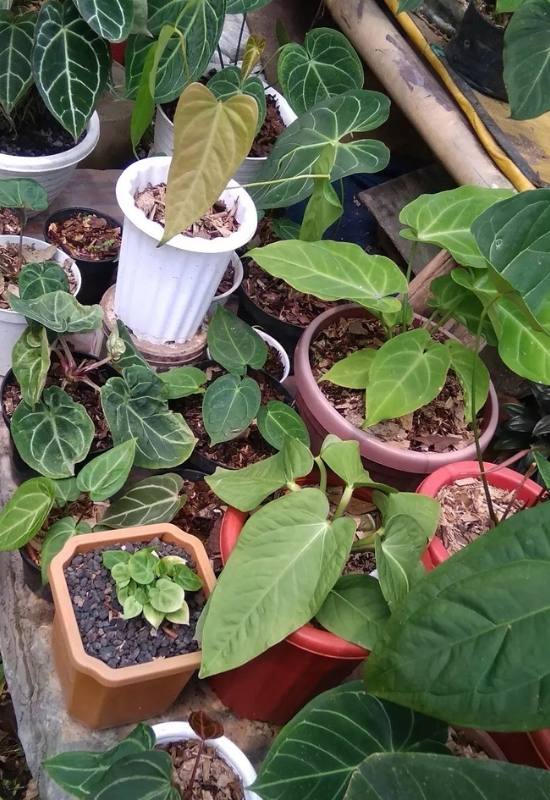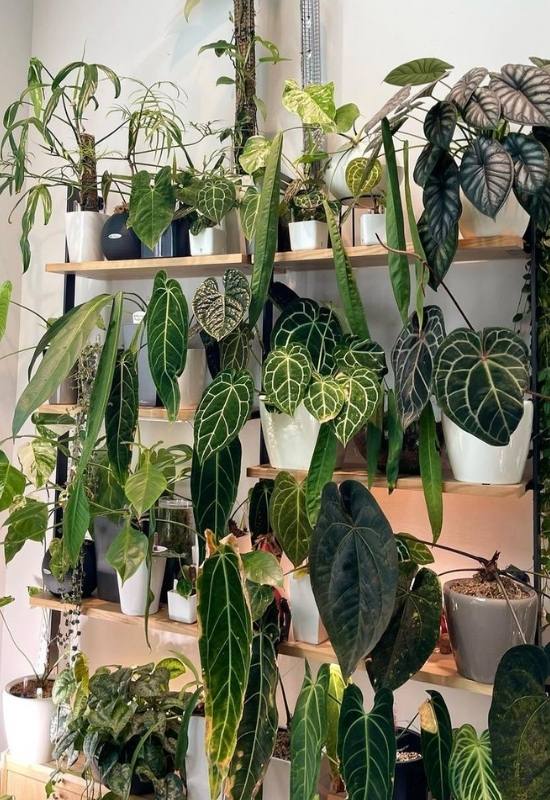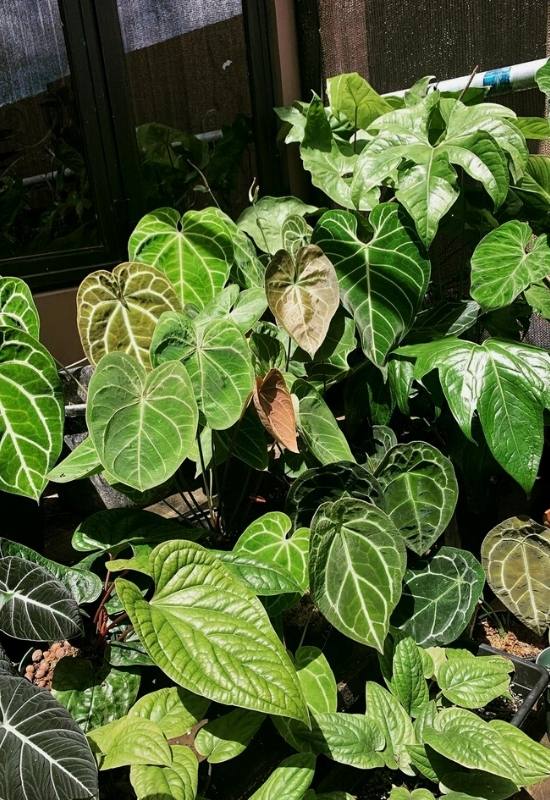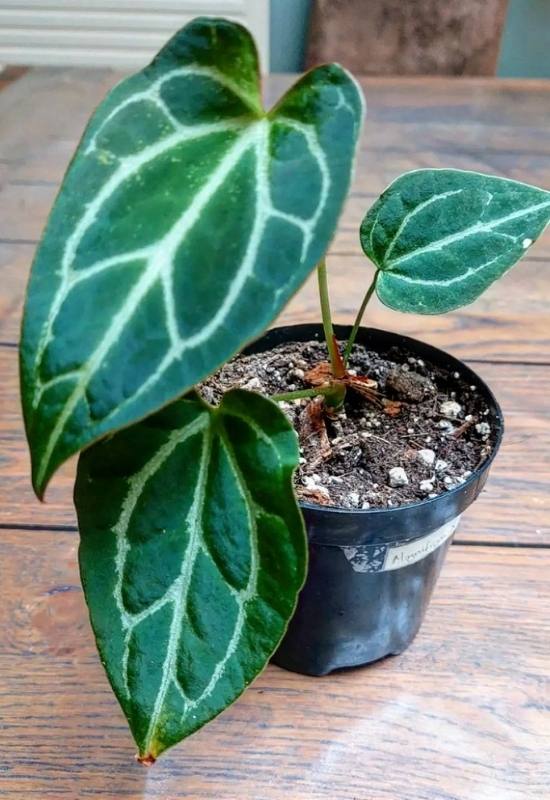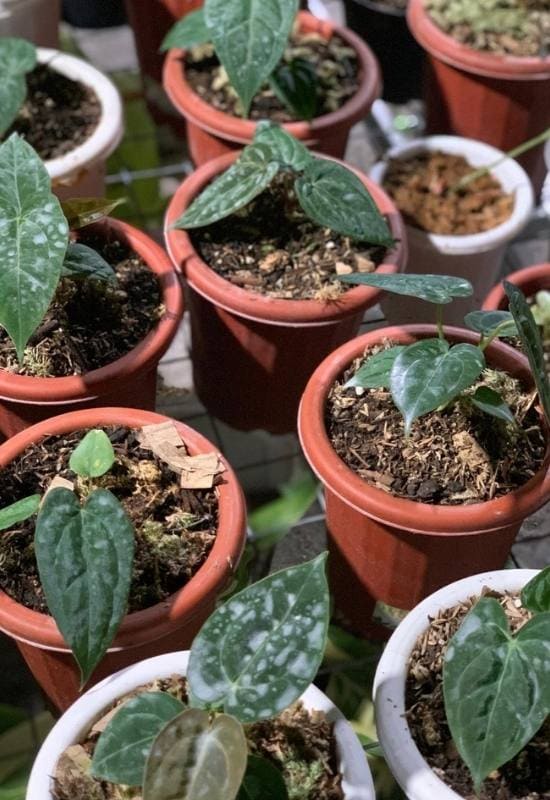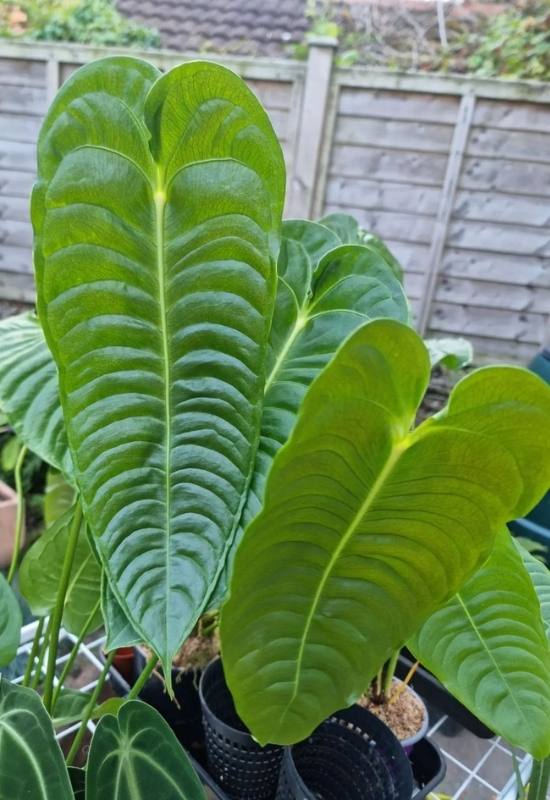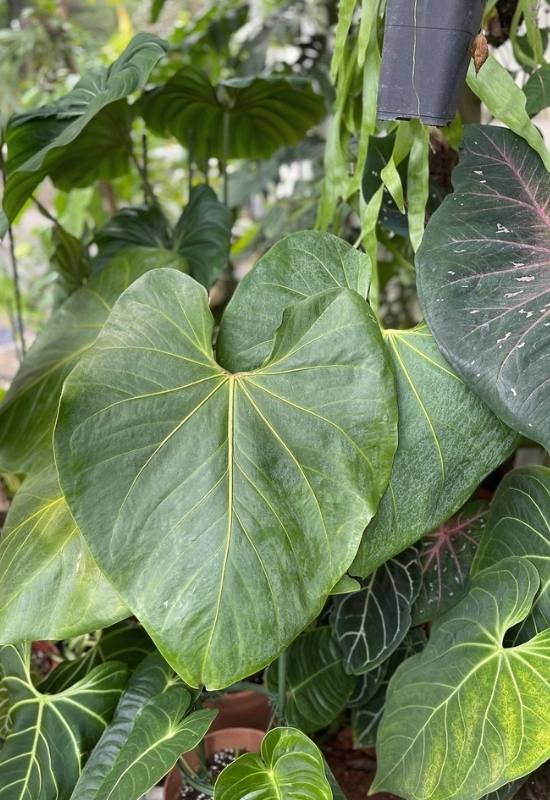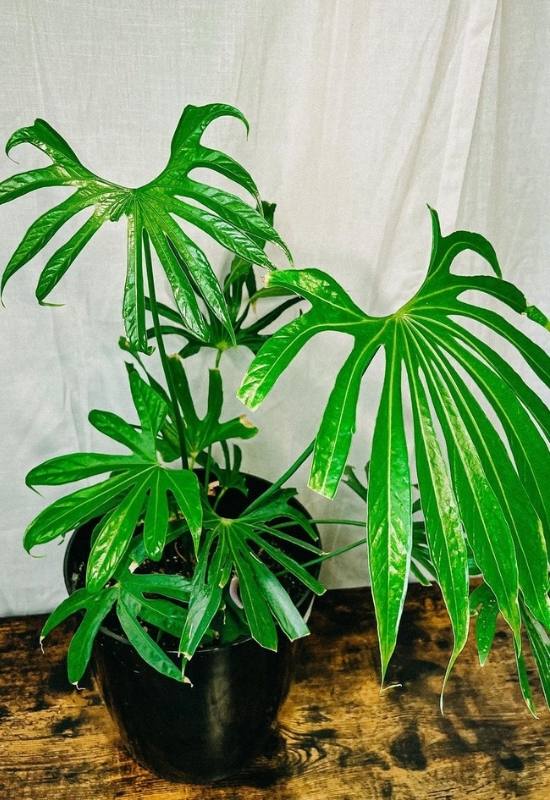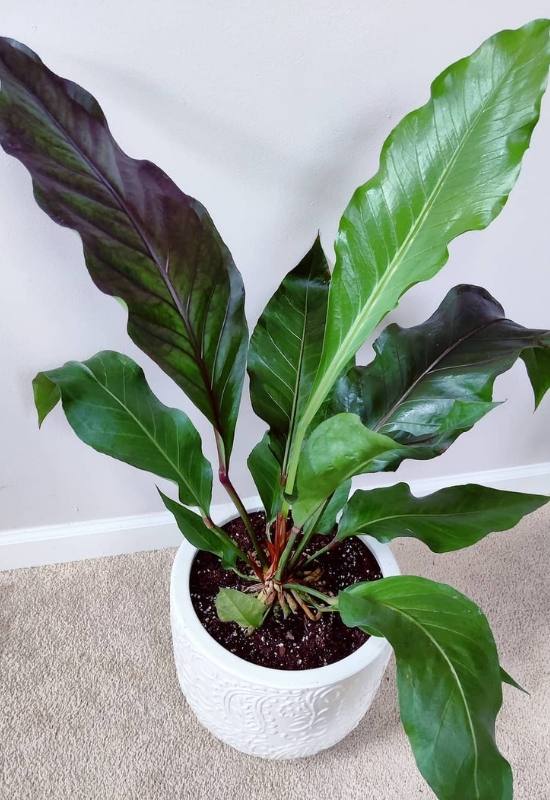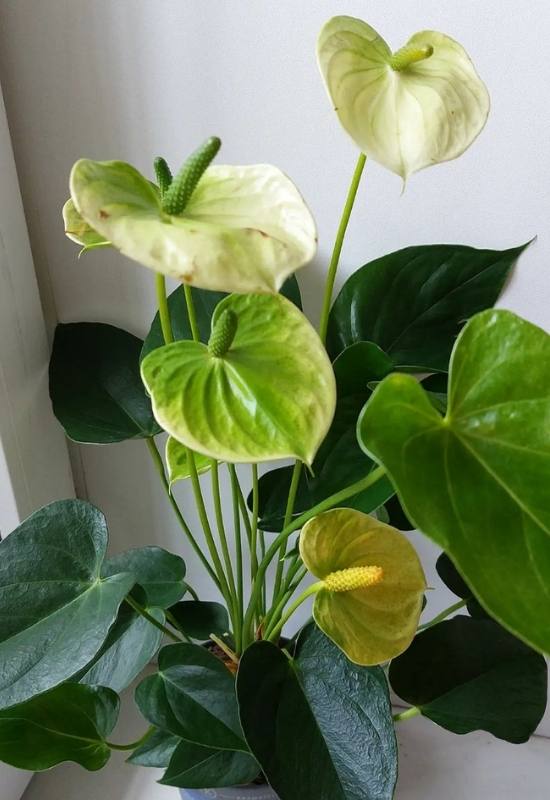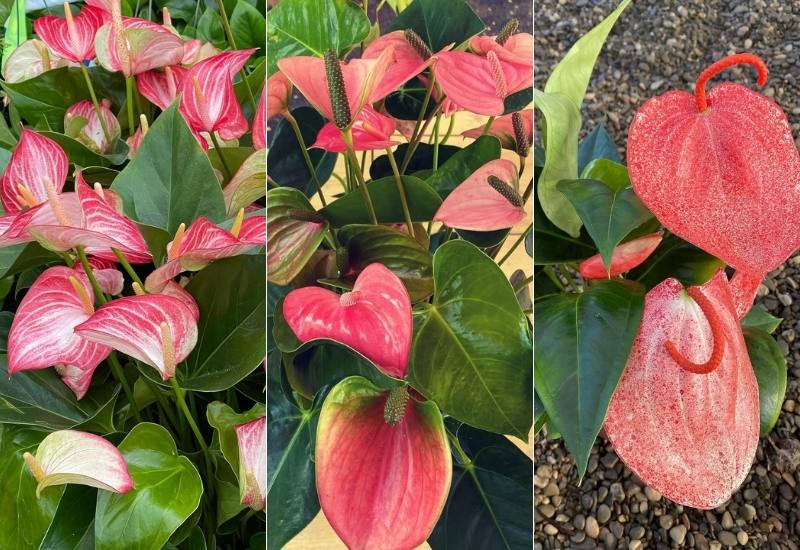
It’s hard to express the decorative value of exotic flamingo flower varieties, or Anthurium… Super glossy, waxy, colorful blooms that look like heart shaped ceramic plates, fleshy, large leaves with a sheen that looks like polish some reaching a whopping 5 feet in size (1.5 meters)! …
A huge range of bright shades in spathes, attractive foliage, which can be variegated, and even decorative berries… Long lasting blossoms, up to 4 months, and coming all year round! No wonder they are favorite houseplants…
Excellent air purifiers indoors, you can grow them outdoors as well, and their tropical presence is always a great spectacle, and the massive range of varieties and its ability to grow in a wide range of habitats is jaw dropping.
Anthurium produces a long-lasting, showy inflorescence in a variety of brightly colored flower spathes including pink, red, orange, yellow, green, blue, purple and even multicolored.
Excellent air purifiers indoors, you can grow them outdoors as well, and their tropical presence is always a great spectacle, and the massive range of flower shapes and colors, as well as its ability to grow in a wide range of habitats is jaw dropping. brightly colored flower spathes
In fact, Anthurium is the largest genus of the huge Araceae family, with more than 1,000 species! Add cultivars and hybrids, and you can get lost in this exotic jungle of flamingo flowers. They change a lot in size, shape, color, and even in how thick the flowers and leaves are.
However, both natural species of Anthurium and cultivars have amazing qualities as houseplants and as garden perennials, and, despite being exotic, they are low maintenance. So welcome to a great journey in the life, care and range of varieties of flamingo flowers!
We are going to start our exotic journey among types of flamingo flowers soon, but first you need to kit up with some information about Anthurium and how to care for it.
Anthurium: A Closer Look At Flamingo Flower
Native of Central and South America, Anthurium has a very evocative common name: flamingo flower, possibly because its exotic shape reminds us of these colorful birds. Even the scientific name refers to animals: in fact, anthosmeans “flower” and ourameans “tail” in Greek, and it refers to the spadix.
True, the spadix of this genus is arguably the most impressive asset as a decorative houseplant: its colors are incredibly bright, and its glossy and waxy texture just highlights the vibrant shades, from white to purple, with reds, pinks, and even greens on its palette.
Most anthurium varieties bloom last for an impressive 2 to 3 months and can repeat throughout the year, making it a very valuable houseplant. The blooms are followed by juicy berries of many colors, depending on the variety. These usually contain seeds.
Additionally, the flamingo flower has another theme: hearts! Both the spathes and leaves are shaped like hearts, and these are just as attractive as the blooms! Large, glossy, and fleshy, they often have clear veins running through them. However, their shape can vary somewhat – some are elongated while others are broad.
However, not all spathes and leaves are heart-shaped (cordate) as we will see… Some are quite unusual, such as spearheads or enormous hands with many digits. The creased, relief-like surface of both spathes and foliage provides beautiful light effects and gives the whole plant a really sculptural feel
Anthurium Indoors and Outdoors
Flamingo flowers are mainly indoor houseplants; this is not only because they “look the part”…
They also require warm and stable temperatures, but you can grow them in your garden, on condition that you live in USDA zones 11 to 12 and that your area is not classed as a semi-desert or desert because they need constant humidity.
Some varieties, especially big ones, or extremely large leaf ones, are best suited for exotic outdoor gardens.
Anthurium: Great Air Purifiers
A NASA study on good plants to cleanse the environment from toxins has established that Anthurium is one of the best air purifiers, thanks to its large leaves.
They are great at absorbing ammonia, formaldehyde, toluene, and xylene, and in fact, they are recommended for workplaces, especially near copiers, printers, and adhesives!
Anthurium: Symbolism and Feng Shui
Anthurium is a trendy present for friends and family members, maybe because they last long, undoubtedly because they are gorgeous, and perhaps because they symbolize hospitality.
Or maybe because in Feng Shui, it is a lucky plant that helps you with your social relationships.
Anthuriums: Decorative Value
While most people identify Anthurium with its showy, glossy blooms, there are wide varieties that are better appreciated for their foliage.
Some have small flowers, but all have exciting and decorative leaves. But now, here are some more specific details about this colorful houseplant.
Anthurium Fact Sheet
Sometimes having all facts in a simple and clear way can help you understand growing a decorative plant, which is why we have compiled a fact sheet on Anthurium for you.
How to Care for Anthurium Plants
As we said, one of the reasons why the flamingo flower, or Anthurium, is a great and popular houseplant is that it is low maintenance.
You won’t need to do much to keep it healthy and glossy and get it to bloom again and again. So, let’s see all you need to know.
Anthurium Light Requirements
Anthurium needs bright or medium indirect light indoors; it will also tolerate low light conditions but will not flower. Keep it at least 5 feet away from the window (1.5 meters) unless it is north-facing.
East and west-facing windows are best, but south-facing ones will be fine. If you grow it outdoors, it needs dappled or partial shade.
It prefers morning sunlight and afternoon shade if you can afford these conditions.
Anthurium Water Needs
Anthurium has low to medium watering needs; despite being exotic, it does not get too thirsty. Allow the soil to dry almost completely before watering, as long as it is not fully dry.
How often will depend on the climate, but it is usually every 5 to 7 days from spring to fall and every 10 to 14 days in winter.
Only give your flamingo flower a little water to moisten the soil but not make it soggy. Wet soil and overwatering are dangerous for Anthurium because its fleshy leaves can easily catch root rot.
Overwatering is the leading cause of disease with flamingo flowers.
Anthuriums Soil Requirements
Many Anthuriums are epiphytes, so they don’t need soil to grow but a growing medium. A good and simple mix is 1 part orchid bark, 1 part peat moss or substitute (coco coir), and 1 part perlite.
If you plan on growing your flamingo flower outdoors, in your garden, it needs very well-drained loam or sand-based soil, it does not need to be fertile, but it will not tolerate chalk or heavy clay.
The soil pH should range between 5.5 and 6.5, rather acidic, but if it reaches neutral to about 7.0, it will manage just fine.
Anthurium Temperature and Humidity
Anthurium comes from warm regions of Central and South America, where temperatures never drop too low. The best range for the flamingo flower is between 70 and 85F (21 to 30C).
Flamingo flowers will manage days at warmer levels, up to 95oF, or 35oC, without problems.
It can also thrive at lower temperatures; down to 55oF, or 13oC, a reasonably standard level in winter, even indoors, it will still do well, but it won’t bloom willingly.
Problems start when the temperature drops to under 45oF, or 7oC, because it may even die under this level. Fortunately, this rarely ever happens indoors.
Also, Anthurium needs reasonably high humidity levels above 50%. This is more than in most indoor spaces, so… Take a giant saucer, put it under the watering saucer of your flamingo flower, and fill it with water.
This way, you will avoid soggy soil and root rot, but you will give it a humid microclimate. A final tip: add some expanded clay pebbles, so the water evaporates slowly.
Fertilizing Anthurium
The Flamingo bloom requires little food. Despite being robust and fleshy, and coming from regions that are extremely fertile, Anthurium is a non-greedy plant. Because they obtain nutrients from the air and water, epiphytes are similar to this.
Only use a very low strength and slow release organic fertilizer, and even reduce the dosage to ½ or even ¼! Only feed it every 3 or 4 months and never in winter. A good NPK is 1-1-1; you can’t get any lighter than this!
Repotting Anthurium
Anthurium does not grow too fast, so it does not need repotting often. Do it when your flamingo flower has outgrown its container, usually every 2 or 3 years. Choose a container that is 1 or 2 inches (2.5 to 5.0 cm) larger.
Remove your Anthurium from the pot. This is a good time to cut dry leaves and spent flowers and then transplant them, adding a new potting mix. But this is also a good time to propagate it. Up next.
Propagating Anthurium
The best way to propagate Anthurium is by clump division. This is simply done:
As a fun fact, the most common propagation method in nurseries is by tissue culture, a very modern and scientific choice that preserves the characteristics of the variety perfectly intact.
But as you can see, you don’t need a lab to propagate your flamingo flower, and now you know all about taking care of your Anthurium, let’s see the best variety you can choose from!
20 Most Beautiful Anthurium Varieties to Grow at Home
There will be some natural species and some cultivars in our list of Anthurium varieties, because these exotic super bloomers are wonderful as they come from Mother Nature, but it’s also true that breeders have introduced some stunning additions as well! So, off we go, ready?
From the 1,000 species and innumerable cultivars, these Anthurium varieties stand out for their amazing tropical beauty.
1: Anthurium Andraeanum (Anthurium andraeanum)
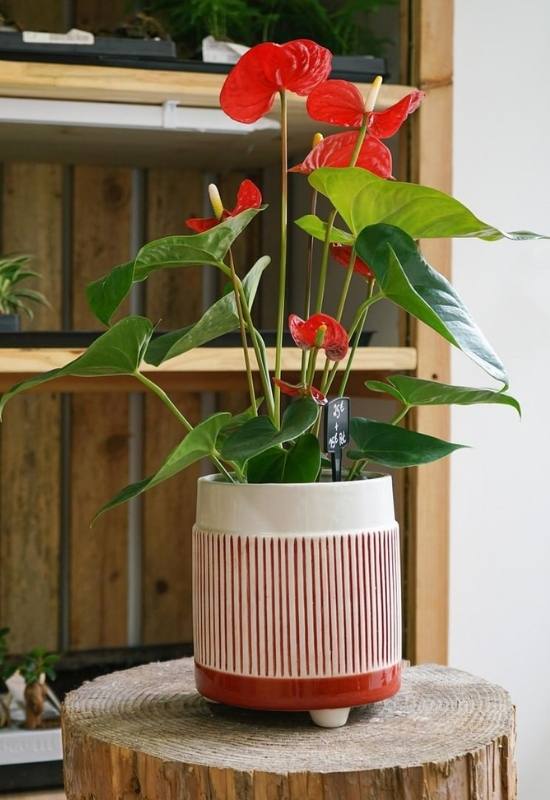
We can start with the most common and widespread of all flamingo flowers: Anthurium andraeanum. Its heart-shaped spathes are waxy, almost like they have been lacquered, heart-shaped, and about 6 inches long (10 cm).
They look like porcelain, and they are traditionally red, though cultivars that we will see have different amazing shades. The spadix is upward and yellow, cream or white.
The leaves are glossy, mid to emerald green, with prominent lobes at the back of the petiole and with lovely, gently curving, decorative veins drawn on the waxy surface. It has deservedly won the prestigious Award of Garden Merit from the Royal Horticultural Society.
Anthurium andraeanum is arguably one of the most popular houseplants worldwide; it is reliable, showy, and gratifying, and the cut flowers will last long as well, up to 4 weeks.
2: Anthurium Crystallinum (Anthurium crystallinum)
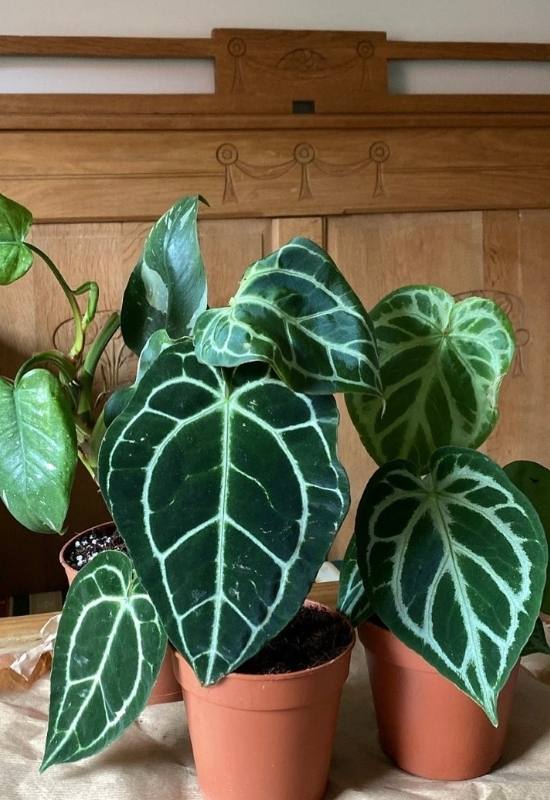
Flamingo flowers don’t just wow us with their blooms, as we said, and Anthurium crystallinum is proof of this. In fact, it is mainly loved for its massive leaves that reach 3 feet long (90 cm) and are super decorative.
Glossy, broad, and heart-shaped, they have clear veins that draw patterns and take part in a fantastic palette of white, greens, copper shades, and even purple!
On the other hand, the spathe is small and narrow, usually white to pinkish, with nothing really exceptional.
The bold presence of Anthurium crystallinum in a room or tropical garden is a great asset because it really expresses the lush, exotic, and oversized foliage of hot and rainy forests.
3: Black Anthurium (Anthurium cabrerense)
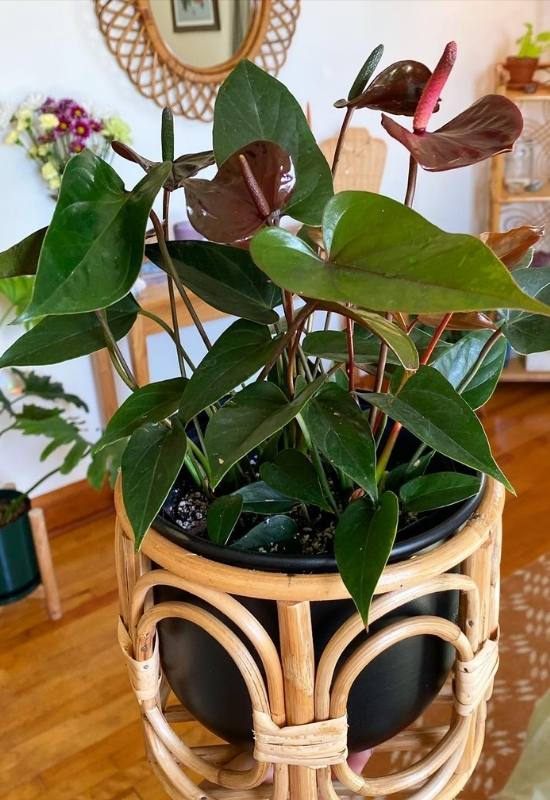
Anthurium cabrerense is not just black in the name! This variety has naturally “black” spathes, meaning that they are of such a dark purple or purple-brown shade that they look the color of the night!
And because they are super waxy and glossy, the effect is mind-blowing! Heart-shaped and pointed, bending forward at the tip, these modified leaves contrast with the bending spadices at their center, which are white to reddish-orange.
The leaves are also shiny, sagittate, or shaped like a spearhead, bright to mid-green, and with a horizontal habit.
Black anthurium offers one of the rarest colors of all flowers, with added sheen, and it is adaptable to indoor and outdoor growing. The variety you choose if you want to take your guests and visitors by surprise!
4: Pigtail Anthurium (Anthurium scherzerianum)
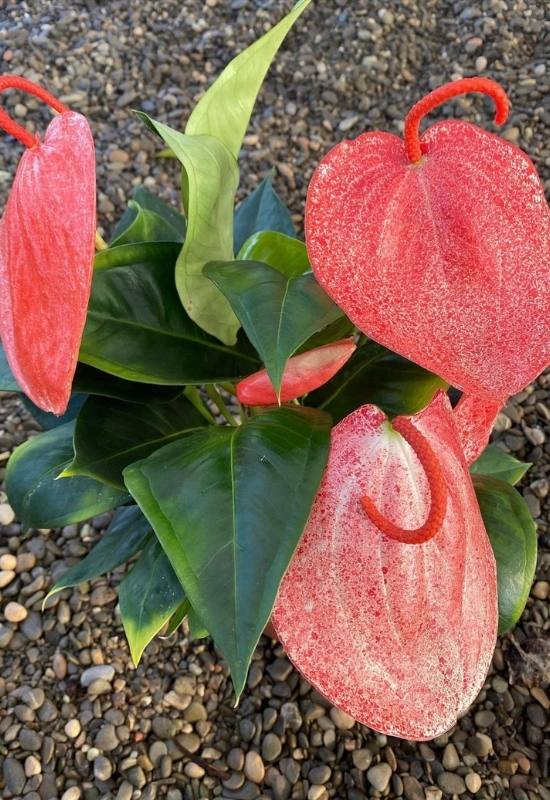
The name of this flamingo flower says it all, pigtail or Anthurium scherzerianum for botanists. The spadix, red in color, is curly, just like the back end of a piglet.
The spathes are bright red, heart-shaped but with small lobes, and of the same eye-catching and energetic color.
They also curve and twist sometimes. The leaves are long and narrow, very pointed, and in a range of greens with a clear undulation that gives you significant light effects.
It is an essential species because hybrids between this variety and Anthurium andreanum have given us some of the best-bred houseplants.
Playful and quirky, pigtail anthurium is a small variety that brings cheerful vivacity to indoor spaces or a fun twist in open gardens.
5: King of Anthuriums (Anthurium veitchii)
King of anthuriums is yet another flamingo flower variety you will love for its foliage. The elongated heart-shaped leaves can reach 4 feet in length (1.2 meters), and they look floppy, pointing to the ground, also because they are heavy.
In a way, they may remind you of the elephant’s ears and display big horizontal grooves, like wrinkles on the glossy green surface.
Maybe not be that suitable indoors unless you have a big room; it will keep the slammer inside. This species also produces strange, long and wavy, white and green spathes, and with a cream-whitish, long and erect spadix.
Maybe the king of anthuriums is funny looking; it is a bit “wobbly” as a plant, but the massive leaves give you the wow factor and a lot of green foliage!
6: Heart Leaf Anthurium (Anthurium clarinervium)
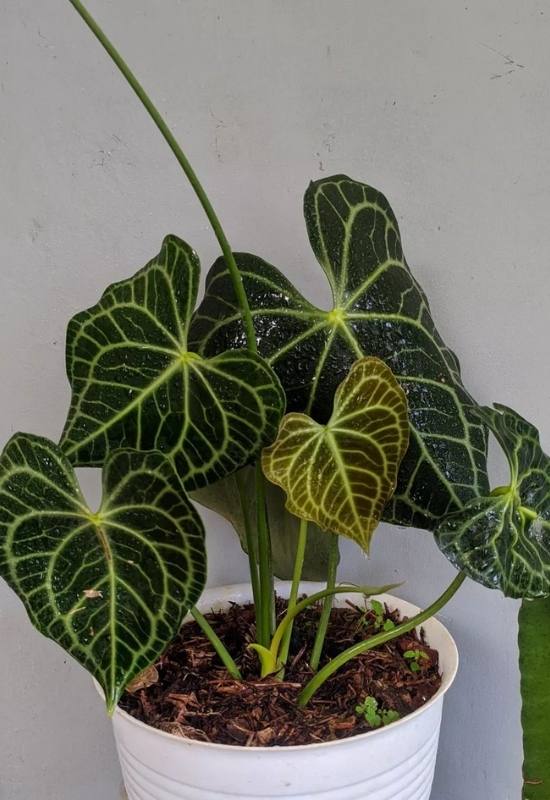
This variety of flamingo flower variety has references to its foliage in both its common and scientific name. Finally, one gives us the shape, fully rounded, pointed, and cordate (like a heart, indeed).
The second refers to the decorative, regular pattern of bright pale green veins on the shiny, dark green background.
However, this backdrop can also turn copper or even wine red sometimes! They look like African masks, pointing down as they do, hanging from their petioles.
The blooms are almost inconspicuous but elegant; they have a very thin, pointed, small white to greenish spathe and an upright spadix. On top of the delicate stems, they look like dragonflies.
Mainly loved for its foliage, heart leaf anthurium is an excellent houseplant because the leaves seem to fly in the air due to the very, very thin petioles.
7: ‘Black Beauty’ Anthurium (Anthurium andraeanum ‘Black Beauty’)
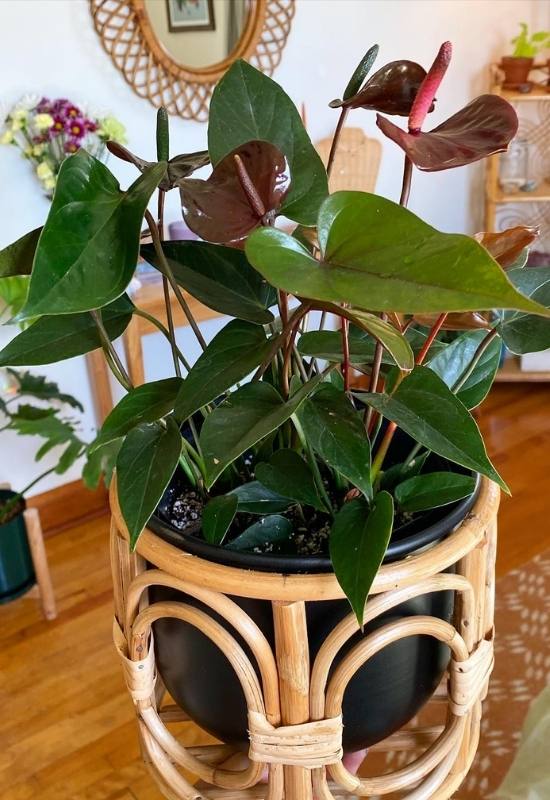
This cultivar of the popular Anthurium andraeanum will blow your mind off! It has deep plum purple spathes, broad and super glossy like they have just been polished and waxed!
The stems, too, take up this unusual color, while the spadices range from green to purple and pink. Then there’s the heart-shaped, horizontal foliage. With a lovely sheen and cordate, it also takes on a range of shades from copper to green with a purple blush.
Small and quite elegant, ‘Black Beauty’ has more shades in it than the name would suggest. A classy and sculptural houseplant for an important spot on your table or desk, in a focal point.
8: Queen Anthurium (Anthurium warocqueanum)
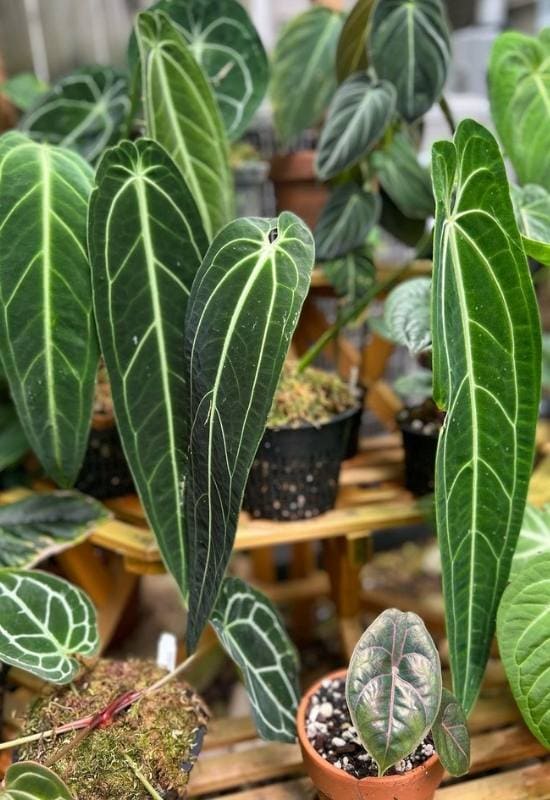
If you like contrasts of light and darkness, Queen anthurium’s foliage is jaw-dropping. It has long, narrow, and pretty pointed leaves, nodding down towards the ground from their petioles, with a very dark green backdrop decorated with a spider-like vein pattern that stands out like in a painting.
Overall, they look like Zulu shields, to give you an idea. The length varies greatly, from a few inches (especially indoors) to a whopping 4 feet (1.2 meters). On the contrary, the flowers are very inconspicuous, thin, narrow, and white-greenish.
For a bold statement, queen anthurium is a great choice! It can decorate a room with its unique, contrasting foliage. Mainly grown in greenhouses and indoors rather than outdoors.
9: Faustino’s Giant (Anthurium faustomirandae)
When it comes to foliage size, no flamingo flower can match Faustino’s giant or Anthurium faustomirandae! They can reach a mind-blowing 5 feet in both length and width (1.5 meters)!
Floppy and leathery, cordate in shape and mid-green on color, these hang down from the petioles like massive sheets or huge, soft hearts! The blooms appear at the base of the plant in this case.
They are calla lily shaped, with spathes that are cream on the outside and a delicate hay green inside, with a brownish cream, conical spadix. Pointed at the tips, like hoods, these can reach 10 inches long (25 cm).
Not your average houseplant, Faustino’s giant is more of a botanical garden attraction; however, many fans of this soft-looking colossus of the Anthurium genus grow it in greenhouses all over the world.
10: ‘White Lady’ Anthurium (Anthurium amnicola ‘White Lady’)
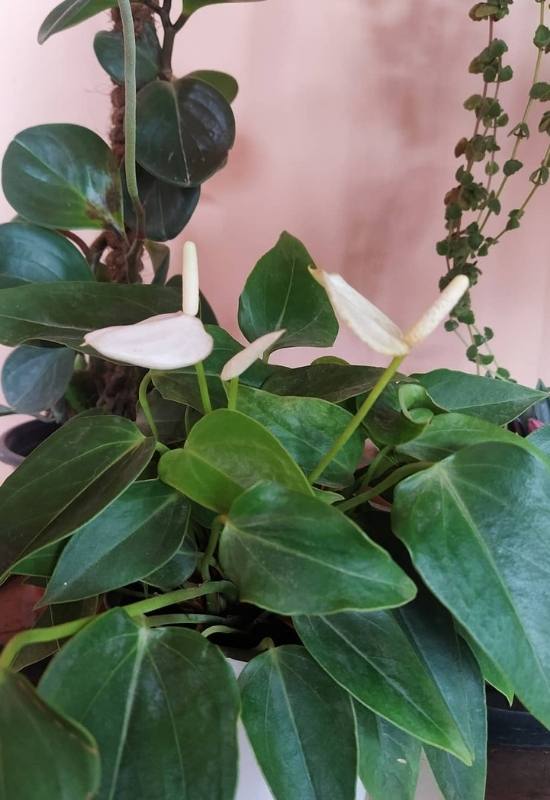
Elegant and delicate looking, ‘White Lady’ is a flamingo flower variety that brings peace and calm to any indoor space. The blooms consist of elongated white spathes, sometimes with a twisting tip and cream-white spadices.
These come on slender stems above the thin foliage, which is deep green, glossy, and quite smooth for anthuriums.
Lanceolate, or “lance-shaped” rather than cordate, the leaves point out and up, framing the floral display, but only partly. The overall look is that of butterflies flying above a green field.
‘White Lady’ will look wonderful in a neat, light, elegant room. It is mainly an indoor variety. It is also small so that you can fit it on a bookshelf.
11: Laceleaf (Anthurium regale)
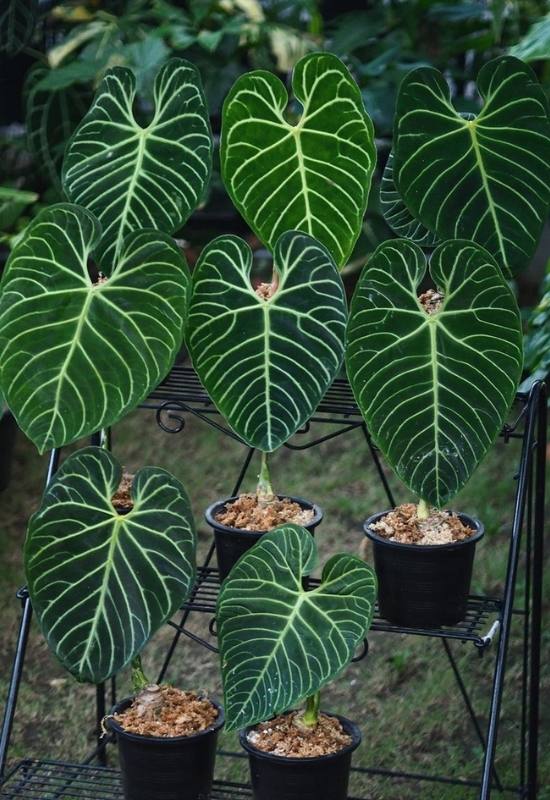
Laceleaf will not produce lots of foliage, but what leaves! This flamingo flower variety, known to botanists as Anthurium regale, “royal anthurium” is stingy with quantity but generous with size and quality.
You get the one, two, and three heart-shaped leaves with lovely, harmonic, and balanced heart shapes, but they are also velvety and big! You cannot miss them by reaching 4 feet long (1.2 meters) and 3 feet in width (90 cm).
Also, the mid to dark green of the surface is decorated with a unique, elegant relief pattern of white or sometimes yellowish veins, hence its name. The blooms are totally inconspicuous; on the other hand, small, thin, and green.
A much-loved houseplant by those who know it, laceleaf has a sculptural quality that you can hardly match with any other flamingo flower variety. The one leaf on a thin stem look is hard to repeat!
12: Tulip Anthurium (Anthurium amnicola)
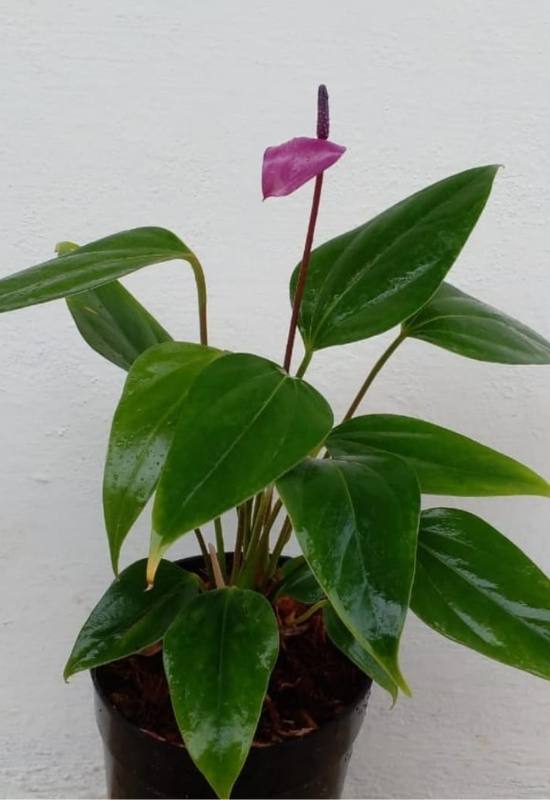
The name of this Anthurium variety gives us a clear clue about it: it looks like a tulip! In fact, the spathes are pointed, and when they are still closed, they look like a bud of the iconic Dutch flower.
They are lilac in color, and now some cultivars play with different shades, pushing their range from white to magenta.
Also, the purple spadix does not start from the base of the bloom but has a short stem. The leaves are not heart-shaped but elliptical and elongated and not as glossy as in other types of flamingo flowers.
One of the best varieties for gardens, tulip anthurium looks great in informal, even herbaceous beds and borders. It is less common indoors.
13: ‘Rainbow Champion’ Anthurium (Anthurium andraeanum ‘Rainbow Champion’)
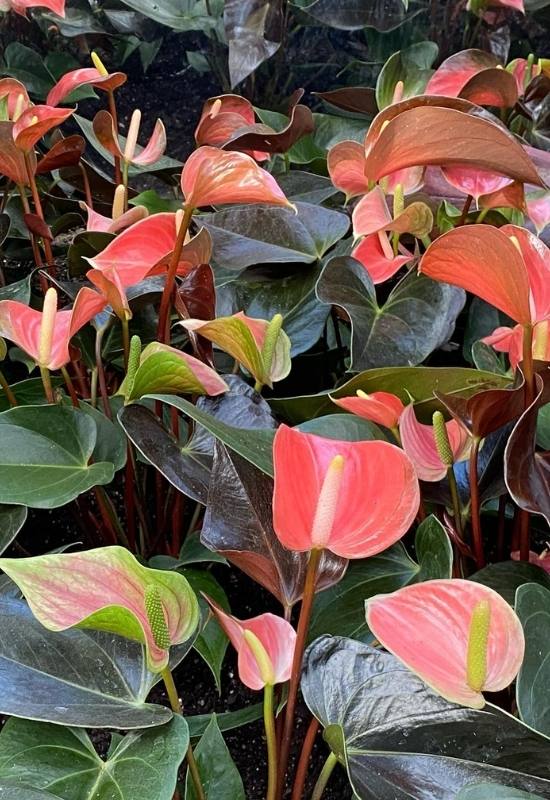
If you love colors, you can’t miss ‘Rainbow Chanpion’, a cultivar of Anthurium andraeanum of the ‘Livium’ series.
The palette of this variety is just amazing, in fact! The blooms consist of long, pointed spathes that are convex, and they look like boats.
They can be red, white, green, mulberry, or any mix of these shades! And they fade seamlessly into each other!
Glossy and with gentle veins lengthways, they perfectly fit the shiny leaves, which are rhomboid and with pointed tips, very sculptural.
And they are green but with a solid copper blush on them! The stems add a final touch with their russet tones.
The mellow but showy mix of colors and sophisticated hues of the ‘Rainbow Champion’ flamingo flower make it a very sought-after indoor variety; fairly expensive, it needs to be on full display in an elegant room.
14: Anthurium Clavigerum (Anthurium clavigerum)
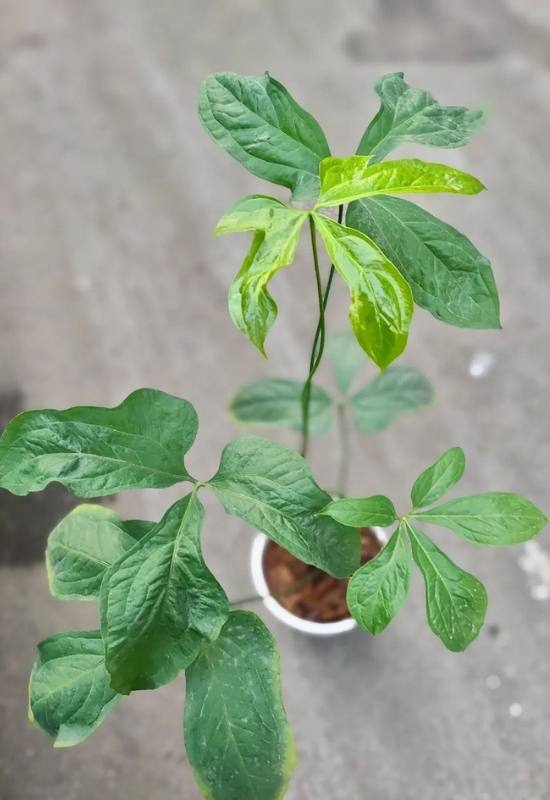
Meet the real rebel of the flamingo flower genus: Anthurium clavigerum. You may not even recognize it as a member of this group because the leaves are fully palmate, with 7 to 12 long, arching, and lobed leaflets.
Bright to mid-green, these form very decorative clumps where foliage is the real protagonist, creating a rich and intriguing texture.
Each can reach up to 6.6 feet in length and width (2 meters)! The blooms look like very long toucan bills, and they are white and purple in color. What’s more, this variety is a climber! Very unusual indeed.
Anthu clavigerum is an excellent vine for exotic gardens; its value to pergolas, harbors, and trellises is really great, thanks to its tropical look.
15: Paddle-Leaf Anthurium (Anthurium coriaceum)
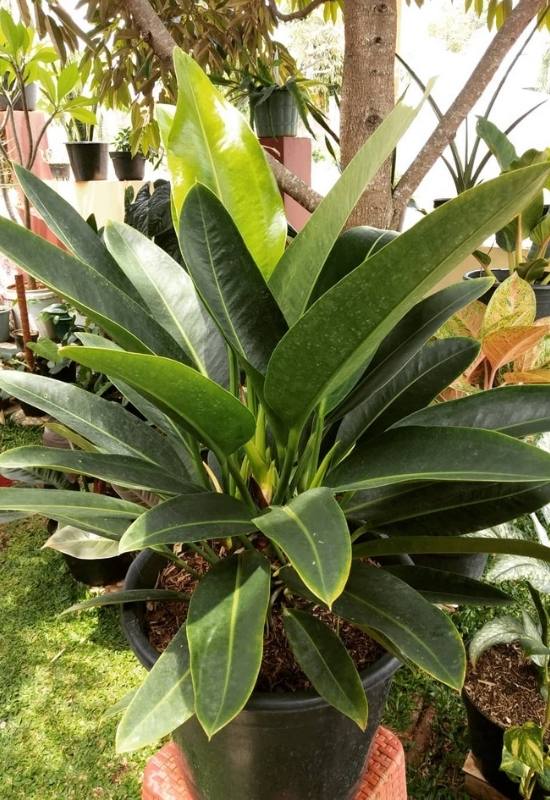
Paddle leaf anthurium is yet another very unusual variety. The foliage is deep green, elliptical, complex, lengthy, and with a clear point. Lastly, the leaves point proudly upwards, like spears, and reach 4 feet long (1.2 meters).
The undulation they display is very regular, like a 3D decoration. At the base of this sculptural rosette, you will find very thick stems and large, purple blooms with massive spadices!
Yet another garden variety, paddle leaf anthurium, is an ideal specimen plant, thanks to its statuesque silhouette, which makes a perfect focal point in an elegant garden.
16: Anthurium ‘Livium’ (Anthurium andraeanum ‘Livium’)
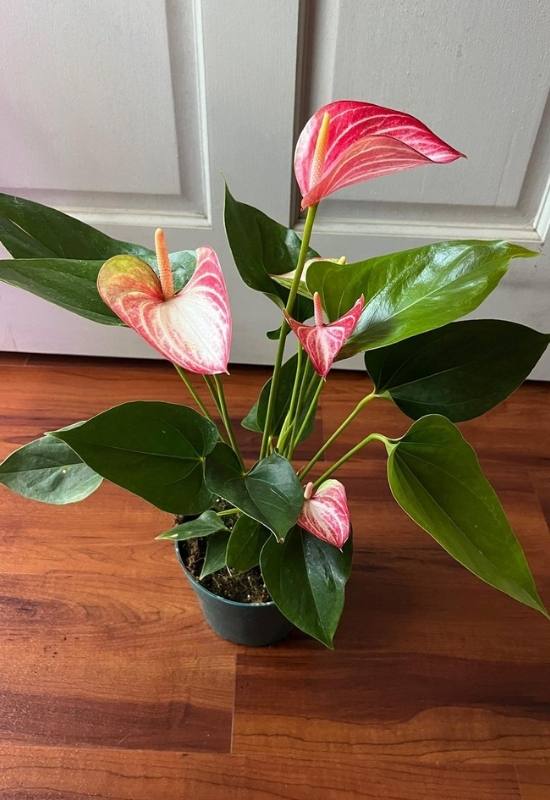
If you want to make your room bright and cheerful, ‘Livium’ is the flamingo flower variety that will catch your eye. This cultivar of Anthurium andraeanum has showy pink spathes with lovely white stripes that make them shine.
There is also a red variety, ‘Livium Red,’ and the range is growing all the time! The glossy mid to deep green leaves are elongated. They look lanceolate, or spear-shaped, rather than heart-shaped.
The foliage forms a lovely elegant clump, making the perfect backdrop for the energetic and generous flower display.
A perfect houseplant full of energy and positivity, ‘Livium’ is an anthurium cultivar that’s growing in popularity every day!
17: Anthurium Fingers (Anthurium pedatoradiatum)
The younger leaves of anthurium fingers are heart-shaped, like in most other varieties. But when they grow, they look like hands with long and thin fingers because they develop deep lobes that make them palmate….
And they do grow a lot, up to 2 feet long and wide (60 cm)! Glossy and arching beautifully, the foliage is the main attraction of this species, while the blooms are pretty but not showy; small, thin, and greenish to yellow spathes and spadices will spring up at the base of this exotic-looking perennial.
Equally suitable for indoor and outdoor gardening, anthurium fingers offer you an unusual variation on the genus but very exotic. It is interesting to watch the leaves change shape over time!
18: Pearl Laceleaf (Anthurium scadens)
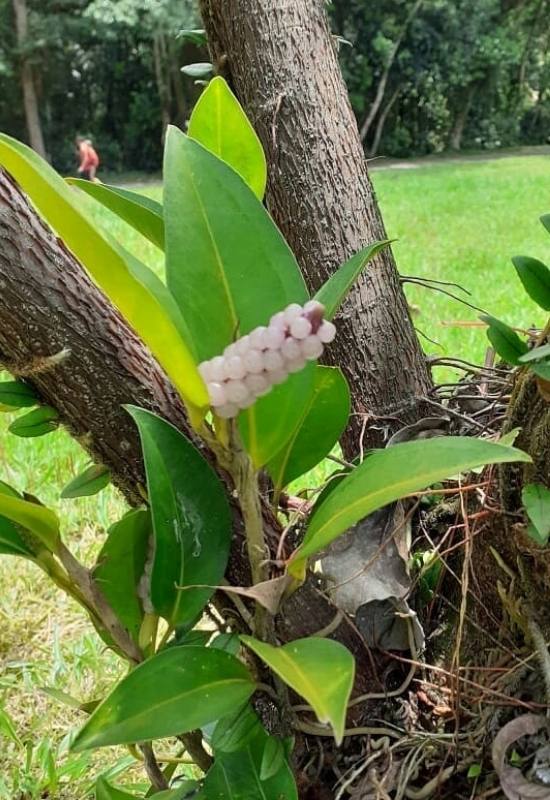
Pearl laceleaf is a small but unique variety of Anthurium because its main attraction is neither the foliage nor the blooms… No, it is famous for its berries, which are round, white to pink, and very glossy, and they come in packed little clusters that look like pearls, in fact!
This small plant has lanceolate, glossy leaves that grow on rambling stems with many aerial roots. The flowers are inconspicuous, with a small thin green spathe that looks like a little leaflet and a bigger spadix.
A lesser-known variety loved by its fans, pearl laceleaf is a good houseplant for small spaces or an exciting addition to your collection of exotic plants in an outdoor garden.
19: Bird’s Nest Anthurium (Anthurium hookeri)
Forming a large rosette of foliage like you would find in a tropical rainforest, bird’s nest anthurium is a very showy and sculptural variety of flamingo flowers.
Glossy, long, pointed, and also broad, reaching 3 feet long (90 cm), they are usually mid-green, but they can take on russet and even purplish shade.
They create lovely light effects with a smooth surface and gentle, regular undulation. In terms of birds, this “nest” would fit an eagle, not a sparrow! The long spathes of the inflorescence are green, and the spadix is long, purple, and fluffy looking.
Bird’s nest anthurium is a beautiful exotic garden perennial; for a tropical garden, even as a focal point, and indoors it really adds a super eye-catching element to any décor.
20: Anthurium ‘Simba’ (Anthurium andraeanum ‘Simba’)
Pure white spathes, like ceramic, but with green shades on the edges, by the lobed of the veined and glossy heart they shape: this is the bloom of ‘Simba’ a cultivar of Anthurium andraeanum!
The green shade varies from pea to deep emerald, and the lobes are very deep indeed! Sometimes, the white turns pale pink as well!
They look like works of art with the yellow-orange or pink spadix in the middle! And they are huge, up to 8 inches long! The leaves are classic looking, heart-shaped, glossy green and always beautiful.
‘Simba’ mixes creativity and elegance in a showy and original display; this flamingo flower variety too is a growing star of the Anthurium world!
Anthuriums: Exotic Wonders!
We find an impressive range of blooms and leaves in the Anthurium genus! From huge delicate and elegant-looking foliage.
From glossy heart-shaped spathes to toucan-looking ones, small, big, colorful… One thing, though unites them all: they express the showy, lush, and unusual essence of what we mean by “tropical” and “exotic”!

Written By
Amber Noyes
Amber Noyes was born and raised in a suburban California town, San Mateo. She holds a master’s degree in horticulture from the University of California as well as a BS in Biology from the University of San Francisco. With experience working on an organic farm, water conservation research, farmers’ markets, and plant nursery, she understands what makes plants thrive and how we can better understand the connection between microclimate and plant health. When she’s not on the land, Amber loves informing people of new ideas/things related to gardening, especially organic gardening, houseplants, and growing plants in a small space.

